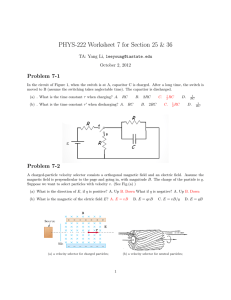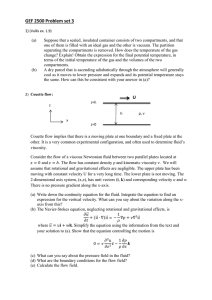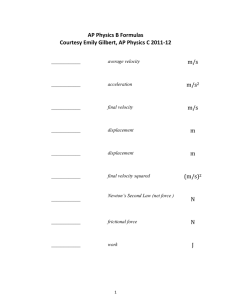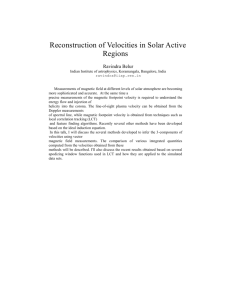International Journal of Application or Innovation in Engineering & Management... Web Site: www.ijaiem.org Email: , Volume 2, Issue 9, September 2013
advertisement
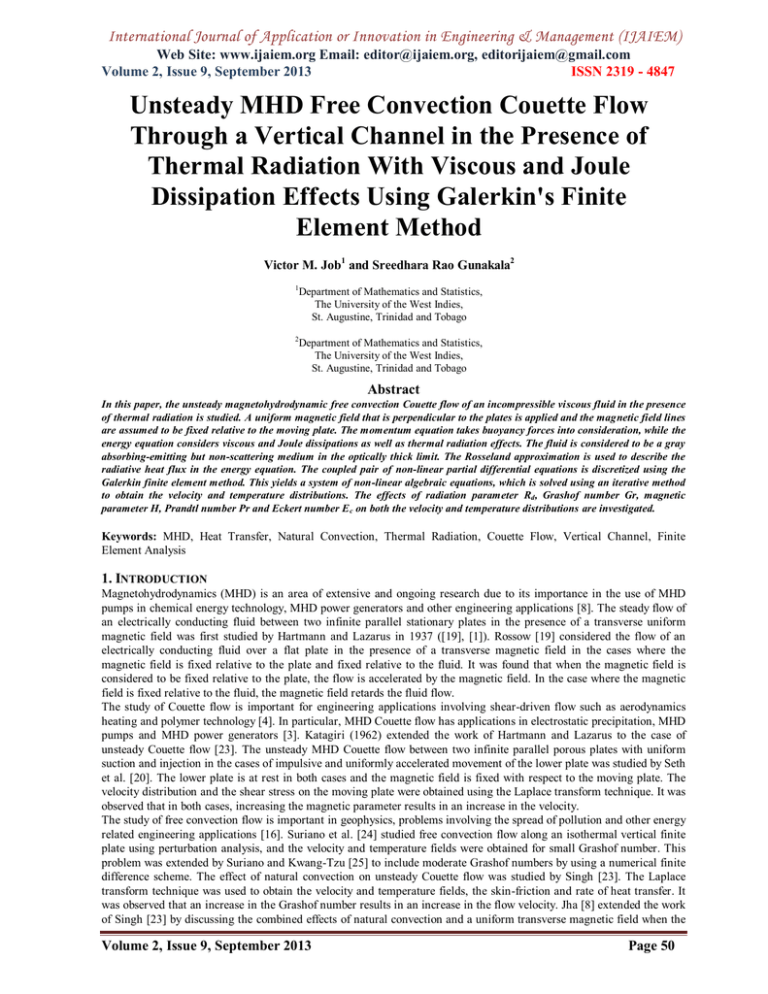
International Journal of Application or Innovation in Engineering & Management (IJAIEM) Web Site: www.ijaiem.org Email: editor@ijaiem.org, editorijaiem@gmail.com Volume 2, Issue 9, September 2013 ISSN 2319 - 4847 Unsteady MHD Free Convection Couette Flow Through a Vertical Channel in the Presence of Thermal Radiation With Viscous and Joule Dissipation Effects Using Galerkin's Finite Element Method Victor M. Job1 and Sreedhara Rao Gunakala2 1 Department of Mathematics and Statistics, The University of the West Indies, St. Augustine, Trinidad and Tobago 2 Department of Mathematics and Statistics, The University of the West Indies, St. Augustine, Trinidad and Tobago Abstract In this paper, the unsteady magnetohydrodynamic free convection Couette flow of an incompressible viscous fluid in the presence of thermal radiation is studied. A uniform magnetic field that is perpendicular to the plates is applied and the magnetic field lines are assumed to be fixed relative to the moving plate. The momentum equation takes buoyancy forces into consideration, while the energy equation considers viscous and Joule dissipations as well as thermal radiation effects. The fluid is considered to be a gray absorbing-emitting but non-scattering medium in the optically thick limit. The Rosseland approximation is used to describe the radiative heat flux in the energy equation. The coupled pair of non-linear partial differential equations is discretized using the Galerkin finite element method. This yields a system of non-linear algebraic equations, which is solved using an iterative method to obtain the velocity and temperature distributions. The effects of radiation parameter Rd , Grashof number Gr, magnetic parameter H, Prandtl number Pr and Eckert number E c on both the velocity and temperature distributions are investigated. Keywords: MHD, Heat Transfer, Natural Convection, Thermal Radiation, Couette Flow, Vertical Channel, Finite Element Analysis 1. INTRODUCTION Magnetohydrodynamics (MHD) is an area of extensive and ongoing research due to its importance in the use of MHD pumps in chemical energy technology, MHD power generators and other engineering applications [8]. The steady flow of an electrically conducting fluid between two infinite parallel stationary plates in the presence of a transverse uniform magnetic field was first studied by Hartmann and Lazarus in 1937 ([19], [1]). Rossow [19] considered the flow of an electrically conducting fluid over a flat plate in the presence of a transverse magnetic field in the cases where the magnetic field is fixed relative to the plate and fixed relative to the fluid. It was found that when the magnetic field is considered to be fixed relative to the plate, the flow is accelerated by the magnetic field. In the case where the magnetic field is fixed relative to the fluid, the magnetic field retards the fluid flow. The study of Couette flow is important for engineering applications involving shear-driven flow such as aerodynamics heating and polymer technology [4]. In particular, MHD Couette flow has applications in electrostatic precipitation, MHD pumps and MHD power generators [3]. Katagiri (1962) extended the work of Hartmann and Lazarus to the case of unsteady Couette flow [23]. The unsteady MHD Couette flow between two infinite parallel porous plates with uniform suction and injection in the cases of impulsive and uniformly accelerated movement of the lower plate was studied by Seth et al. [20]. The lower plate is at rest in both cases and the magnetic field is fixed with respect to the moving plate. The velocity distribution and the shear stress on the moving plate were obtained using the Laplace transform technique. It was observed that in both cases, increasing the magnetic parameter results in an increase in the velocity. The study of free convection flow is important in geophysics, problems involving the spread of pollution and other energy related engineering applications [16]. Suriano et al. [24] studied free convection flow along an isothermal vertical finite plate using perturbation analysis, and the velocity and temperature fields were obtained for small Grashof number. This problem was extended by Suriano and Kwang-Tzu [25] to include moderate Grashof numbers by using a numerical finite difference scheme. The effect of natural convection on unsteady Couette flow was studied by Singh [23]. The Laplace transform technique was used to obtain the velocity and temperature fields, the skin-friction and rate of heat transfer. It was observed that an increase in the Grashof number results in an increase in the flow velocity. Jha [8] extended the work of Singh [23] by discussing the combined effects of natural convection and a uniform transverse magnetic field when the Volume 2, Issue 9, September 2013 Page 50 International Journal of Application or Innovation in Engineering & Management (IJAIEM) Web Site: www.ijaiem.org Email: editor@ijaiem.org, editorijaiem@gmail.com Volume 2, Issue 9, September 2013 ISSN 2319 - 4847 magnetic field is fixed relative to the plate or fluid. Using the Laplace transform technique, exact solutions were obtained for the velocity and temperature fields. The trends observed with respect to the magnetic parameter were consistent with those observed in [19]. The effects of thermal radiation on fluid flow are industrially important in the study of heat transfer where high temperatures are involved. Thermal radiation effects may be non-negligible in engine combustion chambers, furnaces and power plants for gas cooled nuclear reactors [12]. In the limit of an optically thick medium, the radiative flux is related to the temperature using the Rosseland Approximation [10]. The unsteady MHD free convection flow bounded by an infinite vertical porous plate in the presence of thermal radiation was studied by Perdikis and Rapti [11]. The radiative heat flux was described using the Rosseland approximation, and the temperature and suction velocity at the plate were taken to be time-dependent. The velocity and temperature distributions were obtained using an asymptotic expansion of velocity for small magnetic number, as well as a similarity transformation. The results showed a decrease in both velocity and temperature with increasing radiation and suction parameters. Shivaiah and Rao [21] studied Soret and Dufour effects and the effect of thermal radiation on the unsteady MHD free convection chemically reacting flow through a porous medium past an infinite vertical porous plate using the finite element method. The temperature, concentration and suction velocity at the plate and the free stream velocity were all taken to be exponentially accelerated. It was observed that the velocity increases with increasing Grashof number and decreases with increasing magnetic parameter. Both the velocity and temperature decrease with increasing Prandtl number and radiation parameter. Rajput and Sahu [13] investigated the unsteady natural convection hydromagnetic Couette flow between two infinite vertical plates in the presence of thermal radiation. The magnetic field is assumed to be fixed relative to the moving plate, and the cases of impulsive and uniformly accelerated movement of the plate are considered. The Rosseland approximation was used to describe the radiative heat flux. The velocity and temperature distributions, the skin-friction and Nusselt number were obtained using the Laplace transform technique. The authors discovered that the velocity and temperature decrease with increasing Prandtl number and with increasing radiation parameter in both cases. It was also observed that increasing the magnetic parameter increases the velocity in the case of impulsive movement of the plate but decreases the velocity in the case of uniformly accelerated movement of the plate. Increasing the Grashof number results in an increase in the velocity in both cases. Rajput and Sahu [14] later extended their work by including the effect of a heat source or heat sink with constant heat flux at one plate. The results obtained are consistent with those obtained in [13]. In many fluid flows, heat transfer is affected by the motion of the fluid through viscous dissipation as well as by Joule dissipation which is caused by the interaction between the magnetic field and the fluid. Attia [2] considered the problem of unsteady MHD Couette flow of a Newtonian fluid with suction and injection through the plates and viscous and Joule dissipations under a constant pressure gradient. The velocity and temperature distributions were obtained using the finite difference method. The results showed that the velocity decreases as the magnetic field strength increases. Increasing the strength of the magnetic field was shown to increase the temperature at small times but decrease the temperature at large times. Rao and Shivaiah [15] studied the effect of chemical reaction on unsteady flow through a porous medium which is bounded by an infinite vertical oscillating plate with uniformly accelerated temperature and uniform mass diffusion using the finite element method. The results showed that the velocity increases with an increase in the Grashof number and decreases with an increase in the magnetic parameter. An increase in the Eckert number is shown to increase both the velocity and temperature. Shivaiah et al. [22] studied the unsteady MHD mixed convection flow with mass transfer and viscous dissipation past an infinite vertical porous plate in the presence of thermal radiation. The finite element was used to obtain an approximate solution for the velocity, temperature and concentration distributions. The graphical results showed that the velocity increases with increasing Grashof number and with increasing Eckert number. Increasing the Prandtl number and increasing the radiation parameter has been observed to decrease both the velocity and the temperature of the fluid. This paper aims to extend the work of Rajput and Sahu [13] by incorporating the effects of viscous and Joule dissipations. Since the problem is governed by a pair of coupled non-linear partial differential equations, the exact solution is difficult to obtain. Therefore, the problem has been solved using Galerkin’s finite element method. 2. Mathematical analysis Volume 2, Issue 9, September 2013 Page 51 International Journal of Application or Innovation in Engineering & Management (IJAIEM) Web Site: www.ijaiem.org Email: editor@ijaiem.org, editorijaiem@gmail.com Volume 2, Issue 9, September 2013 ISSN 2319 - 4847 Volume 2, Issue 9, September 2013 Page 52 International Journal of Application or Innovation in Engineering & Management (IJAIEM) Web Site: www.ijaiem.org Email: editor@ijaiem.org, editorijaiem@gmail.com Volume 2, Issue 9, September 2013 ISSN 2319 - 4847 3. Numerical Solution by the Finite Element Method 3.1 Spatial Semi-discretization 3.2 Time Discretization Volume 2, Issue 9, September 2013 Page 53 International Journal of Application or Innovation in Engineering & Management (IJAIEM) Web Site: www.ijaiem.org Email: editor@ijaiem.org, editorijaiem@gmail.com Volume 2, Issue 9, September 2013 ISSN 2319 - 4847 For computation of the solution, the spatial domain is divided into 40 line elements, while the time domain is divided into 500 line elements. After assembly of the elements and applying the given boundary conditions (11) and (12), a system of 81 non-linear equations is obtained at each time level. This system of equations is solved using an iteration method, which is repeated until an accuracy of 0.0005 is obtained. 4. RESULTS AND DISCUSSION Volume 2, Issue 9, September 2013 Page 54 International Journal of Application or Innovation in Engineering & Management (IJAIEM) Web Site: www.ijaiem.org Email: editor@ijaiem.org, editorijaiem@gmail.com Volume 2, Issue 9, September 2013 ISSN 2319 - 4847 Volume 2, Issue 9, September 2013 Page 55 International Journal of Application or Innovation in Engineering & Management (IJAIEM) Web Site: www.ijaiem.org Email: editor@ijaiem.org, editorijaiem@gmail.com Volume 2, Issue 9, September 2013 ISSN 2319 - 4847 Volume 2, Issue 9, September 2013 Page 56 International Journal of Application or Innovation in Engineering & Management (IJAIEM) Web Site: www.ijaiem.org Email: editor@ijaiem.org, editorijaiem@gmail.com Volume 2, Issue 9, September 2013 ISSN 2319 - 4847 Volume 2, Issue 9, September 2013 Page 57 International Journal of Application or Innovation in Engineering & Management (IJAIEM) Web Site: www.ijaiem.org Email: editor@ijaiem.org, editorijaiem@gmail.com Volume 2, Issue 9, September 2013 ISSN 2319 - 4847 Volume 2, Issue 9, September 2013 Page 58 International Journal of Application or Innovation in Engineering & Management (IJAIEM) Web Site: www.ijaiem.org Email: editor@ijaiem.org, editorijaiem@gmail.com Volume 2, Issue 9, September 2013 ISSN 2319 - 4847 Volume 2, Issue 9, September 2013 Page 59 International Journal of Application or Innovation in Engineering & Management (IJAIEM) Web Site: www.ijaiem.org Email: editor@ijaiem.org, editorijaiem@gmail.com Volume 2, Issue 9, September 2013 ISSN 2319 - 4847 5. CONCLUSION Volume 2, Issue 9, September 2013 Page 60 International Journal of Application or Innovation in Engineering & Management (IJAIEM) Web Site: www.ijaiem.org Email: editor@ijaiem.org, editorijaiem@gmail.com Volume 2, Issue 9, September 2013 ISSN 2319 - 4847 REFERENCES Volume 2, Issue 9, September 2013 Page 61

